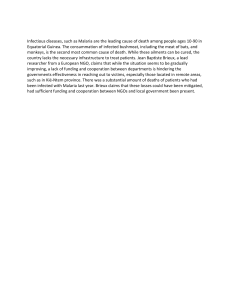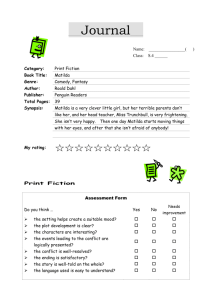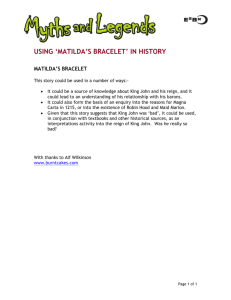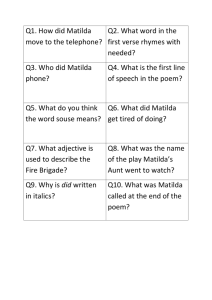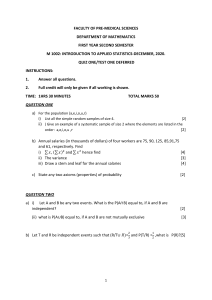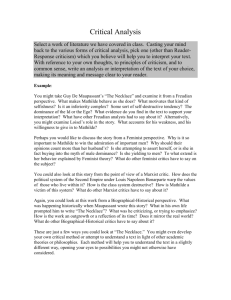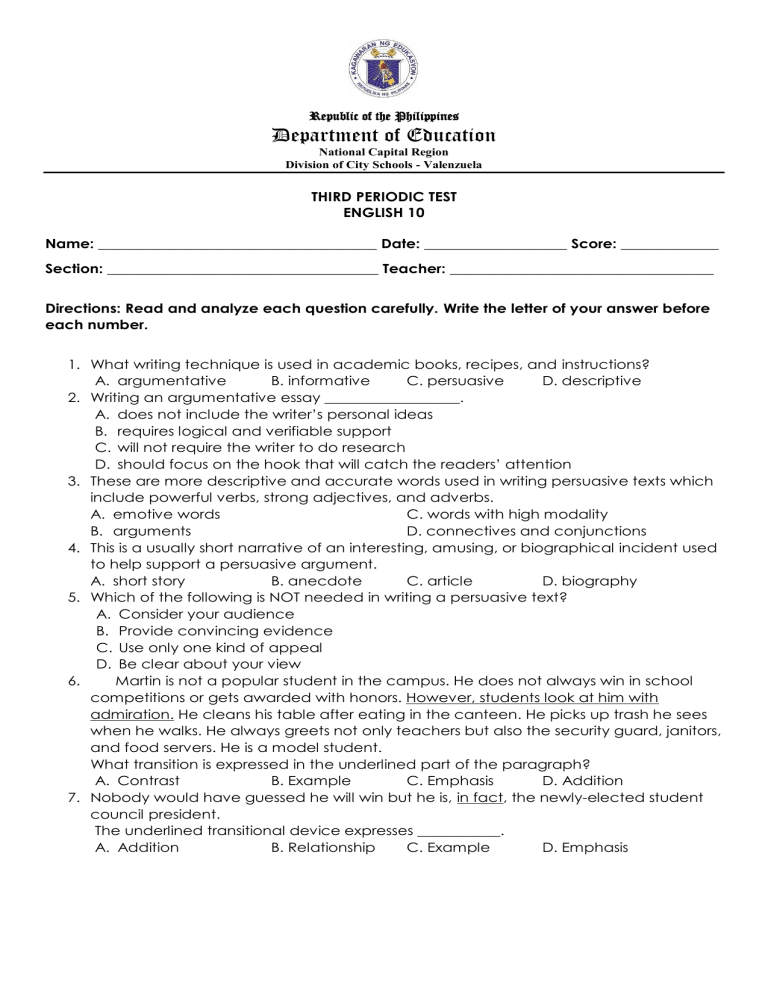
Republic of the Philippines Department of Education National Capital Region Division of City Schools - Valenzuela THIRD PERIODIC TEST ENGLISH 10 Name: _____________________________________ Date: ___________________ Score: _____________ Section: ____________________________________ Teacher: ___________________________________ Directions: Read and analyze each question carefully. Write the letter of your answer before each number. 1. What writing technique is used in academic books, recipes, and instructions? A. argumentative B. informative C. persuasive D. descriptive 2. Writing an argumentative essay __________________. A. does not include the writer’s personal ideas B. requires logical and verifiable support C. will not require the writer to do research D. should focus on the hook that will catch the readers’ attention 3. These are more descriptive and accurate words used in writing persuasive texts which include powerful verbs, strong adjectives, and adverbs. A. emotive words C. words with high modality B. arguments D. connectives and conjunctions 4. This is a usually short narrative of an interesting, amusing, or biographical incident used to help support a persuasive argument. A. short story B. anecdote C. article D. biography 5. Which of the following is NOT needed in writing a persuasive text? A. Consider your audience B. Provide convincing evidence C. Use only one kind of appeal D. Be clear about your view 6. Martin is not a popular student in the campus. He does not always win in school competitions or gets awarded with honors. However, students look at him with admiration. He cleans his table after eating in the canteen. He picks up trash he sees when he walks. He always greets not only teachers but also the security guard, janitors, and food servers. He is a model student. What transition is expressed in the underlined part of the paragraph? A. Contrast B. Example C. Emphasis D. Addition 7. Nobody would have guessed he will win but he is, in fact, the newly-elected student council president. The underlined transitional device expresses ___________. A. Addition B. Relationship C. Example D. Emphasis For items 8-12, read the essay below. 1Malaria is an infectious disease caused by parasites that are transmitted to people through female Anopheles mosquitoes. 2Each year, over half a billion people will become infected with malaria, with roughly 80% of them living in SubSaharan Africa. 3Nearly half a million people die of malaria every year, most of them young children under the age of five. 4Unlike many other infectious diseases, the death toll for malaria is rising. 5While there have been many programs designed to improve access to malaria treatment, the best way to reduce the impact of malaria in Sub-Saharan Africa is to focus on reducing the number of people who contract the disease in the first place, rather than waiting to treat the disease after the person is already infected. 6There are multiple drugs available to treat malaria, and many of them work well and save lives, but malaria eradication programs that focus too much on them and not enough on prevention haven’t seen long-term success in SubSaharan Africa. 7 A major program to combat malaria was WHO’s Global Malaria Eradication Programme. 8Started in 1955, it had a goal of eliminating malaria in Africa within the next ten years. 9Based upon previously successful programs in Brazil and the United States, the program focused mainly on vector control. 10This included widely distributing chloroquine and spraying large amounts of DDT. 11More than one billion dollars was spent trying to abolish malaria. 12However, the program suffered from many problems and in 1969, WHO was forced to admit that the program had not succeeded in eradicating malaria. 13The number of people in Sub-Saharan Africa who contracted malaria as well as the number of malaria deaths had actually increased over 10% during the time the program was active. 14One of the major reasons for the failure of the project was that it set uniform strategies and policies. 15By failing to consider variations between governments, geography, and infrastructure, the program was not nearly as successful as it could have been. 16Sub-Saharan Africa has neither the money nor the infrastructure to support such an elaborate program, and it couldn’t be run the way it was meant to. 17Most African countries don't have the resources to send all their people to doctors and get shots, nor can they afford to clear wetlands or other malaria prone areas.18The continent’s spending per person for eradicating malaria was just a quarter of what Brazil spent. 19Sub-Saharan Africa simply can’t rely on a plan that requires more money, infrastructure, and expertise than they have to spare. Source: https://blog.prepscholar.com 8. Paragraph 2 is called _________________. A. an introductory paragraph B. an evidence C. a body paragraph D. a conclusion 9. The following arguments can be added in the essay’s body paragraphs EXCEPT A. One of the cheapest and most effective ways of preventing malaria is to implement insecticide-treated bed nets. B. It’s estimated that malaria costs Africa 12 billion USD in lost income every year. C. Instead of developing plans to treat malaria after the infection has incurred, programs should focus on preventing infection from occurring in the first place. D. Vector control is more effective than treatment strategies because it means fewer people are getting sick. 10. Which of the following is the essay’s thesis statement? A. Sentence 2 C. Sentence 3 B. Sentence 4 D. Sentence 5 11. Which of the following is TRUE about the essay? A. The introduction of the essay does not lay out the seriousness of the problem. B. The conclusion of the essay is missing. C. There is few research on this essay. D. The thesis appears in second paragraph. 12. What evidences did the writer use to support his reasons? A. expert opinions B. research C. statistics D. observations For items 13-15, write the correct adverb for each blank in the paragraph. Choose from the words in the box. not exactly never undoubtedly no Vacation is (13) ______________ what summer is all about for Filipinos. Boracay, Palawan, and even small resorts are packed with families and friends. However, beaches are (14) ______________ the only summer destination in our country. Baguio and Tagaytay are great options too. Their cool weather and tourist spots are (15) ______________ a great summer combination. For items 16-23, identify the literary theory described in each number. Write the letter before each number. 16. It focuses on how literature presents women as subjects of socio-political, psychological, and economic oppression. A. Moralist B. Formalist C. Feminist D. Marxist 17. It focuses on literary form and the study of literary devices within the text. A. Moralist B. Formalist C. Feminist D. Marxist 18. It studies elements such as language, imagery, point of view, plot structure, and/or character development and motivation. A. Moralist B. Formalist C. Feminist D. Marxist 19. It writes about power struggles between characters, creating stories that revolve around themes such as revolution, sexism, and racism. A. Moralist B. Formalist C. Feminist D. Marxist 20. It examines literature against civil and ethical criteria. A. Moralist B. Formalist C. Feminist D. Marxist 21. Focuses on how literature presents women as subjects of socio-political, psychological, and economic oppression. A. Moralist B. Formalist C. Feminist D. Marxist 22. It judges works based on their ethical teachings or morals. A. Moralist B. Formalist C. Feminist D. Marxist 23. It puts the focus on the social and political content and meaning of literature. A. Moralist B. Formalist C. Feminist D. Marxist 24. Jomar is writing a formalist critique of a short story. Which of the following questions would help him? A. What is the relationship between the characters and their society? B. How is the work’s structure unified? C. How does it accurately reflect the time in which it was written? D. Is the form and content of the work influenced by the writer’s gender? 25. Jackie was assigned to write an analysis of a novel. Which would she NOT look into if she will use the feminist approach? A. How do the male and female characters relate to one another? B. Does the novel challenge or affirm traditional views of women? C. Does the novel view women as superior or inferior? D. Is there paradox, ambiguity, and irony in the work? 26. Which of the following will a writer with a Marxist approach likely do in his work? A. Feature the extravagant life of the wealthy B. Create weak characters from the working class C. Make an uneducated protagonist become successful in the end D. Create a tragic ending for a bullied character 27. Which of the following questions you should ask yourself and answer when writing a Moralist criticism? A. Does the text aim to manipulate the reader or prompt him to do negative things? B. What are the moral teachings that the author presented through the plot, characters, or theme of the piece? C. Does the author's subject or theme present virtues such as honesty, courage, sincerity, maturity, and sensitivity? D. All of the above For items 28-37, identify the literary approaches in the following lines. Write FEMINIST, MORALIST, or MARXIST. “I am not free while any woman is unfree, even when her shackles are very different from my own.” —Audre Lorde __________29. “Right is right, and wrong is wrong, and a body ain’t got no business doing wrong when he ain’t ignorant and knows better.” —Mark Twain __________30. “A house may be large or small; as long as the neighboring houses are likewise small, it satisfies all social requirement for a residence. But let there arise next to the little house a palace, and the little house shrinks to a hut. The little house now makes it clear that its inmate has no social position at all to maintain.” __________28. —Karl Marx __________31. “You see, though nothing mattered to me, I could feel pain, for instance. If any one had struck me it would have hurt me. It was the same morally: if anything very pathetic happened, I should have felt pity just as I used to do in old days when there were things in life that did matter to me.” —Fyodor Dostoevsky __________32. “Men are afraid that women will laugh at them. Women are afraid that men will kill them.” —Margaret Atwood __________33. “The crux of the matter is whether total war in its present form is justifiable, even when it serves a just purpose. Does it not have material and spiritual evil as its consequences which far exceed whatever good might result? When will our moralists give us an answer to this question?” —John Hersey __________34. “The oppressed are allowed once every few years to decide which particular representatives of the oppressing class are to represent and repress them.” —Karl Marx __________35. “The true measure of a man is how he treats someone who can do him absolutely no good.” —Samuel Johnson __________36. “The slave frees himself when, of all the relations of private property, he abolishes only the relation of slavery and thereby becomes a proletarian; the proletarian can free himself only by abolishing private property in general.” —Frederick Engels __________37. “It is easier to live through someone else than to complete yourself. The freedom to lead and plan your own life is frightening if you have never faced it before. It is frightening when a woman finally realizes that there is no answer to the question ‘who am I’ except the voice inside herself.” —Betty Friedan For items 38-45, read the poem below. A Poem of Kabir (Translated by Rabindranath Tagore) There is nothing but water in the holy bathing places and I know that they are useless, for I have bathed in them. The images are all lifeless, they cannot speak– I know, for I have cried aloud to them. The Purana and the Koran are mere words– lifting up the curtain, I have seen. Kabir gives utterance to the words of experience and he knows very well that all other things are untrue. Source: academichelp.net 38. What can be said of the poem’s author, Kabir? A. Kabir was a politician. B. Kabir was a hard worker. C. Kabir was a spiritual man. D. Kabir was a charitable man. 39. What is the poem about? A. life B. religion C. The Koran D. bathing places 40. What approach to literary criticism can be used in the poem? A. Marxist B. Formalist C. Moralist D. Feminist 41. In stanza 1, Kabir says that “there is nothing but water in holy bathing places.” The author believes that… A. the water will clean the people’s spiritual state B. the holy bathing places are mere superstition C. the water is not good for bathing D. the holy bathing places release people from karma 42. What does the author mean in stanza 2? A. Prayers are not effective. C. God is found only in temples. B. God cannot be placed in idols. D. People should cry to God. 43. In stanza 3, “lifting up the curtain” means to say the author saw the holy books in person, which were usually only read by high people in society at the time. What word best describes this statement? A. serious B. controversial C. humorous D. fictional 44. Which of the following is NOT true about Kabir’s beliefs? A. Only experience is the true spirituality. B. The everyday activities we do cannot connect us with God. C. Only experience with God can give us salvation D. To receive salvation, one must bath in holy water, pray to idols, and read holy books. 45. How will you describe the writing style of the author based on the poem? A. simple but deep C. formal and academic B. Informal D. descriptive For items 46-50, read to the text below. A Summary of “The Necklace” by Guy De Maupassant Matilda Loisel lived in a small flat with her husband who worked as a clerk for the Minister of Education. Matilda was a very pretty young lady. Matilda was very unhappy because she always thought that she was born for all luxuries in the world but she had to live a petty and simple life. Matilda became anxious in the week of the party. On asking her she told her husband that she had no jewellery policy with her gown. He suggested that perhaps she could borrow something from her friend Jeanne Forestier. Jeanne heard her story of distress and she generously opened her box of jewels. Matilda borrowed a sparkling diamond necklace. Matilda and her husband attended the gala and had a great time. When Matilda viewed her glory in the mirror, she realized the necklace was missing. They searched for it everywhere but they did not find the necklace. To buy some time from Jeanne, Matilda wrote a letter that she broke the clasp of the necklace and so she sent it for repair. They purchased a similar necklace thirty-six thousand francs using her husband’s inheritance and borrowed money. Matilda gave it to Jeanne who did not care to look at it. Matilda’s life changed dramatically in the next ten years. After ten years, they were able to pay all the money back but by then Matilda had aged a lot. One day, Matilda met Jeanne Forestier. She decided to confess the truth about the necklace. Matilda told her that she had lost the necklace that she borrowed from her and had to pay a huge amount for the replacement. Jeanne was shocked to hear the entire story behind the necklace and she confessed that the necklace Matilda borrowed was a fake, which was not more than worth five hundred francs. 46. What social issue does the author address in the story? A. a person’s position depends on the family where he is born B. an individual’s value is perceived through his wealth C. the poor are always insecure and helpless D. all of the above 47. What approach to literary criticism can be used in analyzing the story? A. Marxist B. Formalist C. Moralist D. Feminist 48. What is the main theme of the story? A. greed and deception C. family and friendship B. good vs. evil D. life and death 49. Which statement proves the materialistic nature of the characters in the story? I. Jeanne heard her story of distress and she generously opened her box of jewels. II. Matilda was very unhappy because she always thought that she was born for all luxuries in the world but she had to live a petty and simple life. III. On asking her she told her husband that she had no jewellery policy with her gown. A. I and II B. II and III C. II only D. I and III 50. What word best describes the main characters’ lives during the ten years that they did so much work to be able to pay for all the money they borrowed? A. hopeful B. miserable C. optimistic D. ashamed

